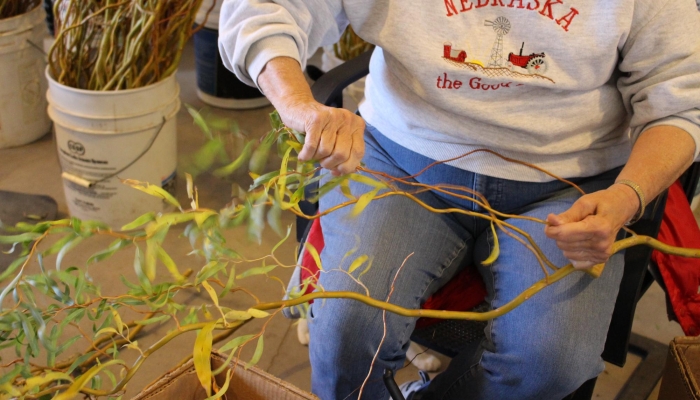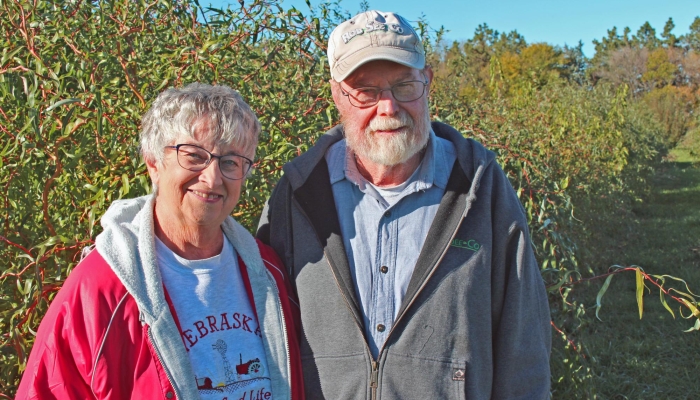Woody Florals
Bradshaw Business Sees Annual Growth
Former NRD Board Member Gary Eberle has a different relationship with trees on his property than most Nebraska farmers. Far from seeing them as a nuisance on a fence line or useful only in a windbreak, Eberle and his wife, Nancy, have cultivated a modest agroforestry business using trees purchased in part through the Upper Big Blue Natural Resources District Conservation Tree Program. Gary also farms 500 acres of no-till corn and soybeans with his son, Kirk, in the Bradshaw area, though he is partially retired from raising row crops and is focused more on the woody florals business.
Woody florals are colorful and highly flexible fresh-cut stems of dogwoods, willows, and other varieties of branches for container and floral arrangements, as well as wreaths and other crafts. The Eberles have been part of the Nebraska Woody Florals co-op since 2006. The branches they grow are sold via the co-op to places like Earl May and Mulhall’s throughout Nebraska and beyond.
The Eberles started producing woody florals when they were looking for another source of farm revenue after they transitioned away from raising livestock. They worked with Ken Feather, the longtime manager of the Upper Big Blue NRD forestry department who retired in 2020, to come up with a tree plan for their property. They started with two rows of varieties of willows and dogwoods, eventually adding more as the business grew. Over the past 15 years, they have experimented with different varieties to find what works the best for their operation. They are also growing several varieties of hazelnut trees for the Arbor Day Foundation to determine which grow best in Nebraska, with an eye toward a future market for sustainable biofuels produced in soils not well suited to other crops.
“I love bare-root planting,” said Gary as he shows off the approximately 80 trees that he and Nancy currently have growing on the one-acre patch of land near their home. Bare-root trees, like the ones available through the NRD’s tree program, tend to grow faster than larger container trees that are available at a nursery, as their root structure is not confined to a compact root ball. Bare-root trees need less time to adjust after planting and typically surpass the size of a more mature container tree in only a few years. They are also much less expensive: a bare-root seedling from the NRD will set you back $1.18, while a larger container tree from a nursery tends to cost over $100.
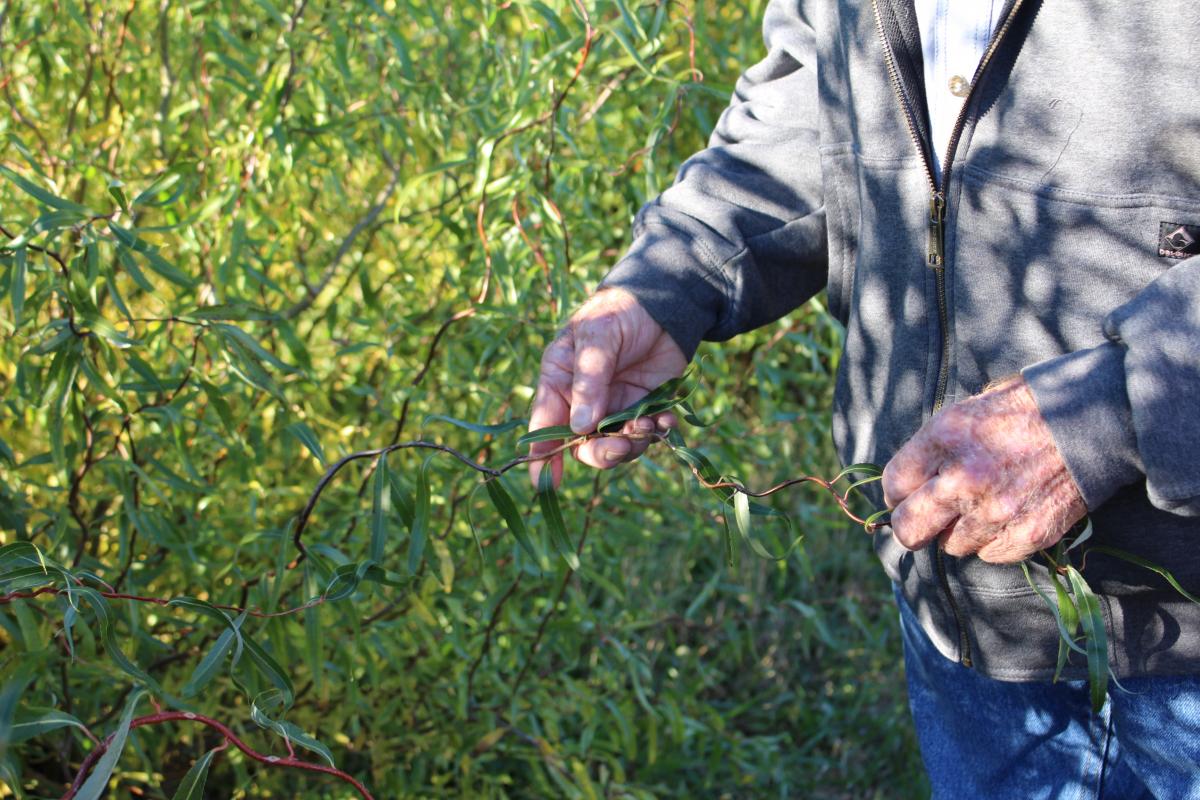
Gary and Nancy currently grow three kinds of willow shrubs and three kinds of dogwoods, each with different colors and textures of branches. They harvest in spring and fall, cutting and processing thousands of stems each year. The demand often out paces the supply, the couple says, but the marketplace is fickle. Gary points out several flame willow shrubs on the perimeter of the tree patch. The flame willows are fast-growing and beautiful, with vibrant foliage and stems. When harvested and stripped of leaves, the long, thin stems are ideal for basket weaving. However, they’ve fallen out of favor, explains Gary with a sigh. They recently cut down several of these bushes and replaced them with red and yellow twig dogwoods. His affection for the less commercially viable variety is apparent.
The rows of bushy shrubs are punctuated by the less dense plants where stems have already been harvested. Gary explains that with each harvest, the plants expand and send out new shoots. The growth at the center where stems have been harvested will die back, but the growth continues around the exterior. The willows are especially prolific growers, adding dozens of new stems and rapidly growing six to ten feet high each year.
Nancy is in the garage stripping leaves from recently harvested stems and bundling the product for delivery. The building is full of buckets of curling, colorful stems towering seven feet high, kept moist and cool to maintain their pliability. Assisted by a friendly barn cat, Nancy gently runs her hand down the stems to remove the leaves and then trims stems to a uniform size. She has set out a collection of wreaths she made from previous years’ harvests, some with a traditional Christmas theme, others more suited to spring, summer, and fall. The branches have been twisted together into a hoop and decorated with silk flowers and leaves, ribbon and bows, ready to add festive charm to any door.
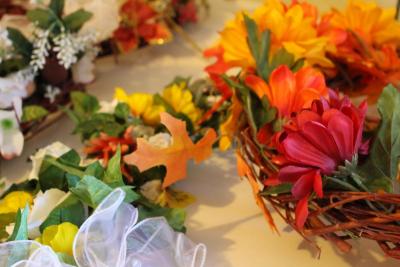 Nancy says this business suits them, as Gary manages the planting, growing, and harvesting, and she oversees the final processing and distribution. The couple likes the woody florals business as it doesn’t require a lot of labor for most of the year, adds diversity to their operation, and the final product provides a lovely addition to a welcoming home. “Woody plants and shrubs can be planted on ground that does not produce well for conventional farming,” said Nancy. “They also are a great addition to buffer strips along stream banks, in windbreaks and alongside living snow fences to buffer winds and collect water. This aids in the productivity and environmental sustainability of the land.”
Nancy says this business suits them, as Gary manages the planting, growing, and harvesting, and she oversees the final processing and distribution. The couple likes the woody florals business as it doesn’t require a lot of labor for most of the year, adds diversity to their operation, and the final product provides a lovely addition to a welcoming home. “Woody plants and shrubs can be planted on ground that does not produce well for conventional farming,” said Nancy. “They also are a great addition to buffer strips along stream banks, in windbreaks and alongside living snow fences to buffer winds and collect water. This aids in the productivity and environmental sustainability of the land.”
Interested in creating a tree plan for your property? Now is the best time to start! Trees have many benefits and can add value to your farm or acreage, depending on your needs and desired outcomes. Call the NRD to set up a time to meet with district forester Kyle Yrkoski to create a plan for a large-scale planting, or order trees via our Conservation Tree Program from December through February. Bare-root trees will be delivered in April, in time for spring planting. Get started at www.upperbigblue.org/trees.
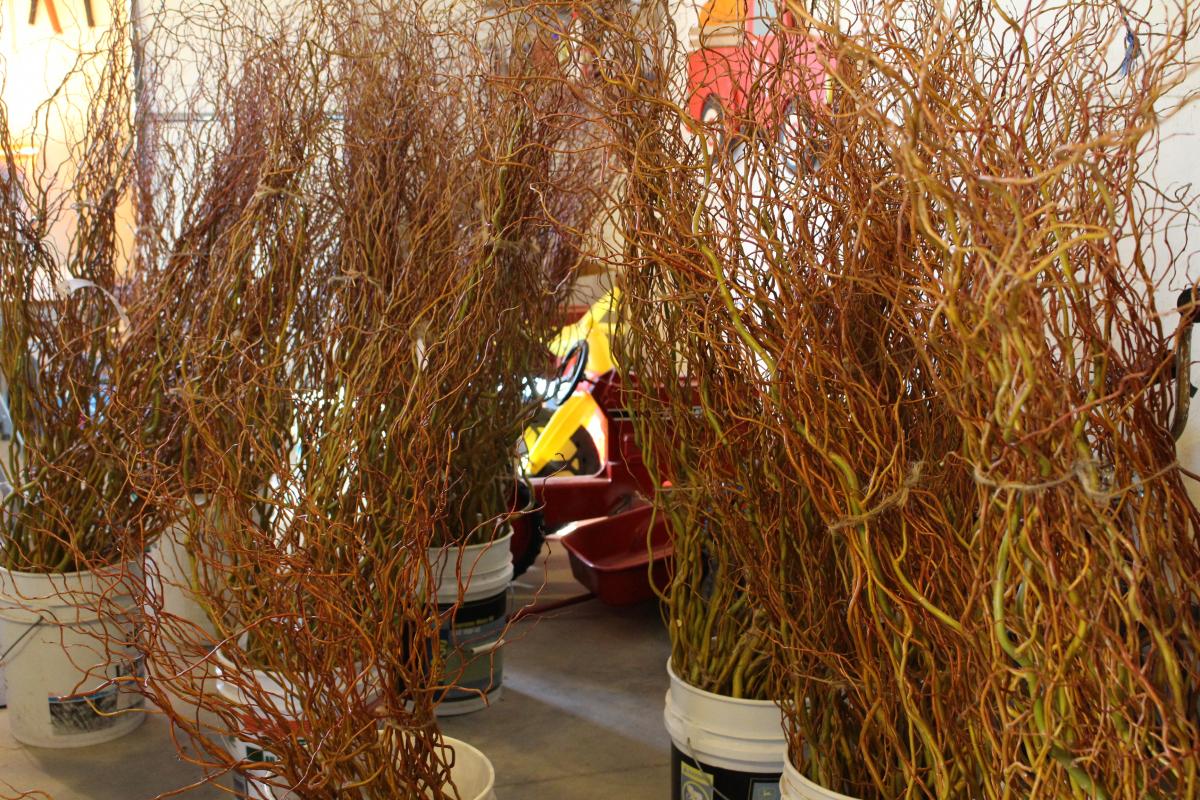
Former NRD Board Member Gary Eberle has a different relationship with trees on his property than most Nebraska farmers. Far from seeing them as a nuisance on a fence line or useful only in a windbreak, Eberle and his wife, Nancy, have cultivated a modest agroforestry business using trees purchased in part through the Upper Big Blue Natural Resources District Conservation Tree Program. Gary also farms 500 acres of no-till corn and soybeans with his son, Kirk, in the Bradshaw area, though he is partially retired from raising row crops and is focused more on the woody florals business.
Woody florals are colorful and highly flexible fresh-cut stems of dogwoods, willows, and other varieties of branches for container and floral arrangements, as well as wreaths and other crafts. The Eberles have been part of the Nebraska Woody Florals co-op since 2006. The branches they grow are sold via the co-op to places like Earl May and Mulhall’s throughout Nebraska and beyond.
The Eberles started producing woody florals when they were looking for another source of farm revenue after they transitioned away from raising livestock. They worked with Ken Feather, the longtime manager of the Upper Big Blue NRD forestry department who retired in 2020, to come up with a tree plan for their property. They started with two rows of varieties of willows and dogwoods, eventually adding more as the business grew. Over the past 15 years, they have experimented with different varieties to find what works the best for their operation. They are also growing several varieties of hazelnut trees for the Arbor Day Foundation to determine which grow best in Nebraska, with an eye toward a future market for sustainable biofuels produced in soils not well suited to other crops.
“I love bare-root planting,” said Gary as he shows off the approximately 80 trees that he and Nancy currently have growing on the one-acre patch of land near their home. Bare-root trees, like the ones available through the NRD’s tree program, tend to grow faster than larger container trees that are available at a nursery, as their root structure is not confined to a compact root ball. Bare-root trees need less time to adjust after planting and typically surpass the size of a more mature container tree in only a few years. They are also much less expensive: a bare-root seedling from the NRD will set you back $1.18, while a larger container tree from a nursery tends to cost over $100.
Gary Eberle examines curly willow stems on his property near Bradshaw.

Gary and Nancy currently grow three kinds of willow shrubs and three kinds of dogwoods, each with different colors and textures of branches. They harvest in spring and fall, cutting and processing thousands of stems each year. The demand often out paces the supply, the couple says, but the marketplace is fickle. Gary points out several flame willow shrubs on the perimeter of the tree patch. The flame willows are fast-growing and beautiful, with vibrant foliage and stems. When harvested and stripped of leaves, the long, thin stems are ideal for basket weaving. However, they’ve fallen out of favor, explains Gary with a sigh. They recently cut down several of these bushes and replaced them with red and yellow twig dogwoods. His affection for the less commercially viable variety is apparent.
The rows of bushy shrubs are punctuated by the less dense plants where stems have already been harvested. Gary explains that with each harvest, the plants expand and send out new shoots. The growth at the center where stems have been harvested will die back, but the growth continues around the exterior. The willows are especially prolific growers, adding dozens of new stems and rapidly growing six to ten feet high each year.
Nancy is in the garage stripping leaves from recently harvested stems and bundling the product for delivery. The building is full of buckets of curling, colorful stems towering seven feet high, kept moist and cool to maintain their pliability. Assisted by a friendly barn cat, Nancy gently runs her hand down the stems to remove the leaves and then trims stems to a uniform size. She has set out a collection of wreaths she made from previous years’ harvests, some with a traditional Christmas theme, others more suited to spring, summer, and fall. The branches have been twisted together into a hoop and decorated with silk flowers and leaves, ribbon and bows, ready to add festive charm to any door.
 Nancy says this business suits them, as Gary manages the planting, growing, and harvesting, and she oversees the final processing and distribution. The couple likes the woody florals business as it doesn’t require a lot of labor for most of the year, adds diversity to their operation, and the final product provides a lovely addition to a welcoming home. “Woody plants and shrubs can be planted on ground that does not produce well for conventional farming,” said Nancy. “They also are a great addition to buffer strips along stream banks, in windbreaks and alongside living snow fences to buffer winds and collect water. This aids in the productivity and environmental sustainability of the land.”
Nancy says this business suits them, as Gary manages the planting, growing, and harvesting, and she oversees the final processing and distribution. The couple likes the woody florals business as it doesn’t require a lot of labor for most of the year, adds diversity to their operation, and the final product provides a lovely addition to a welcoming home. “Woody plants and shrubs can be planted on ground that does not produce well for conventional farming,” said Nancy. “They also are a great addition to buffer strips along stream banks, in windbreaks and alongside living snow fences to buffer winds and collect water. This aids in the productivity and environmental sustainability of the land.” Interested in creating a tree plan for your property? Now is the best time to start! Trees have many benefits and can add value to your farm or acreage, depending on your needs and desired outcomes. Call the NRD to set up a time to meet with district forester Kyle Yrkoski to create a plan for a large-scale planting, or order trees via our Conservation Tree Program from December through February. Bare-root trees will be delivered in April, in time for spring planting. Get started at www.upperbigblue.org/trees.


